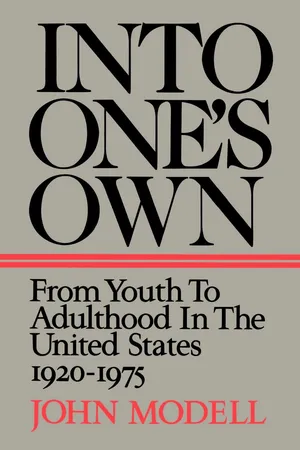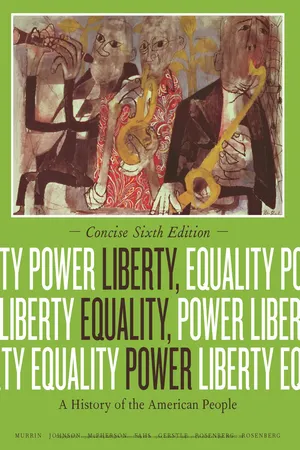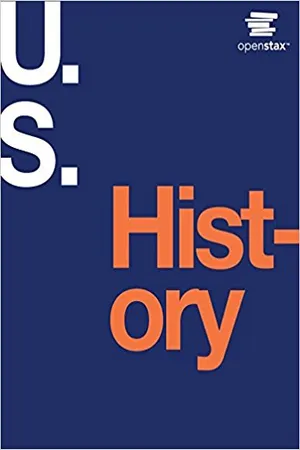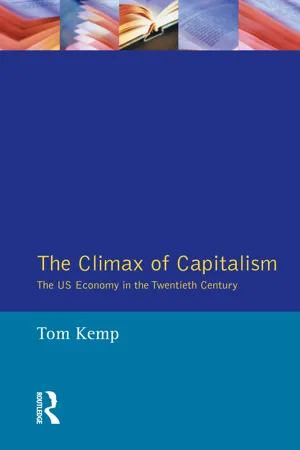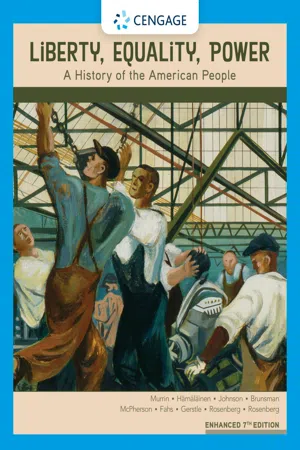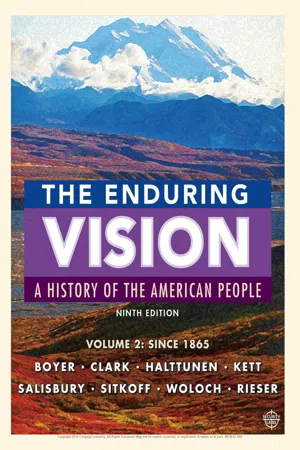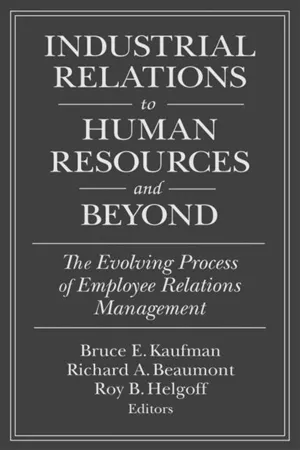History
1920s
The 1920s, often referred to as the "Roaring Twenties," was a decade of significant social, cultural, and economic change in many parts of the world. It was characterized by a booming economy, technological advancements, and a shift towards modernity. The era also saw the rise of jazz music, the flapper culture, and significant changes in women's rights and societal norms.
Written by Perlego with AI-assistance
Related key terms
1 of 5
7 Key excerpts on "1920s"
- eBook - PDF
Into One's Own
From Youth to Adulthood in the United States, 1920-1975
- John Modell(Author)
- 2023(Publication Date)
- University of California Press(Publisher)
3 MODERN YOUTH: THE 1920s CULTURAL INNOVATION That the 1920s was not a decade of unalloyed prosperity as myth proposes should not blind us to the pervasiveness of cul- tural themes reflecting a sense of growing plenty that fed and was fed by a focus on the post-Victorian sense of individualized satisfaction. If some elements of the consumer economy lagged, many evolved rapidly. 1 New expectations and elements of a re- vised organization of the youthful life course emerged from an enlarging and increasingly self-confident middle class, ineluc- tably intertwined. In the 1920s, the United States moved a long way toward reducing the enormous heterogeneity that had been created by the headlong development of an urban nation and had for half a century focused the nation's cultural and political energies. Immigration, to take the most obvious example, severely con- stricted by the Great War, was now sharply reduced by statute. The proportions of the foreign-born who were passing through their childbearing years declined sharply, not compensated for by a comparable increase in second-generation "ethnic" youth. Emigration and death, in addition to cultural adaptation, both consciously foisted and unplanned, worked their effects on the foreign-born community. As the "second generation" of the last great stream of immigration grew up in the 1920s, the once- acute sense that heterogeneity was a "problem" for American democracy began to fade. Evidences of ethnic and cultural dis- continuities, to be sure, were still numerous; but a sense of gradual assimilation had begun to overwhelm more conflictual imagery. The twenties began with a sharp depression, as overoptimis- tic entrepreneurs failed to anticipate the degree of retardation 67 68 Modem Youth: The 1920s the changeover to a peacetime economy would entail, and pre- cipitated a sharp depression. - No longer available |Learn more
Liberty, Equality, Power
A History of the American People, Concise Edition
- John Murrin, Paul Johnson, James McPherson, Alice Fahs(Authors)
- 2013(Publication Date)
- Cengage Learning EMEA(Publisher)
Many Americans, however, reaffirmed their belief that God ’ s word transcended science; that people should obey the moral code set forth in the Bible; that women were not equal to men; and that blacks, Mexicans, and eastern European immigrants were inferior to Anglo-Saxon whites. They made their voices heard in a resurgent Ku Klux Klan and the fundamentalist movement, and on issues such as evolution and immigration. Modernists and traditionalists confronted each other in party politics, in legislatures, in courtrooms, and in the press. Their battles belie the vision of the 1920s merely as a time for the pursuit of leisure. 551 Copyright 2014 Cengage Learning. All Rights Reserved. May not be copied, scanned, or duplicated, in whole or in part. WCN 02-300 P ROSPERITY From 1919 to 1921, the economy faltered as the country struggled to redirect industry from wartime to civilian production. But, from 1922 to 1929, the gross national product grew at an annual rate of 5.5 percent. The unemployment rate never exceeded 5 percent, and real wages rose about 15 percent. A Consumer Society In the 19th century, economic growth had rested primarily on the production of capital goods, such as factory machinery and railroad tracks. In the 1920s, growth rested more on consumer goods. Some products, such as cars and telephones, had been available since the early 1900s, but in the 1920s their sales reached new levels. In 1920, just 12 years after Ford introduced the Model T, 8 million cars were on the road. By 1929, there were 27 million — one for every five Americans. Other consumer goods became available for the first time: tractors, washing machines, refrigerators, radios, and vacuum cleaners. The term “ consumer durable ” was coined to describe such goods, which, unlike food, clothing, and other perishables, were meant to last. - eBook - PDF
- P. Scott Corbett, Volker Janssen, John M. Lund, Todd Pfannestiel, Paul Vickery, Sylvie Waskiewicz(Authors)
- 2014(Publication Date)
- Openstax(Publisher)
Scott Fitzgerald’s Tales of the Jazz Age, embodies the popular view of the 1920s as a nonstop party, replete with dancing, music, flappers, and illegal drinking. Chapter 24 | The Jazz Age: Redefining the Nation, 1919-1929 693 24.1 Prosperity and the Production of Popular Entertainment By the end of this section, you will be able to: • Discuss the role of movies in the evolution of American culture • Explain the rise of sports as a dominant social force • Analyze the ways in which the automobile, especially the Model T, transformed American life In the 1920s, prosperity manifested itself in many forms, most notably in advancements in entertainment and technology that led to new patterns of leisure and consumption. Movies and sports became increasingly popular and buying on credit or “carrying” the debt allowed for the sale of more consumer goods and put automobiles within reach of average Americans. Advertising became a central institution in this new consumer economy, and commercial radio and magazines turned athletes and actors into national icons. MOVIES The increased prosperity of the 1920s gave many Americans more disposable income to spend on entertainment. As the popularity of “moving pictures” grew in the early part of the decade, “movie palaces,” capable of seating thousands, sprang up in major cities. A ticket for a double feature and a live show cost twenty-five cents; for a quarter, Americans could escape from their problems and lose themselves in another era or world. People of all ages attended the movies with far more regularity than today, often going more than once per week. By the end of the decade, weekly movie attendance swelled to ninety million people. The silent movies of the early 1920s gave rise to the first generation of movie stars. Rudolph Valentino, the lothario with the bedroom eyes, and Clara Bow, the “It Girl” with sex appeal, filled the imagination of millions of American moviegoers. - eBook - ePub
The Climax of Capitalism
The U.S. Economy in the Twentieth Century
- Tom Kemp(Author)
- 2014(Publication Date)
- Routledge(Publisher)
Table 2.1 ), continuing and confirming the position of the United States as the leading industrial country and setting the pace tor the other advanced countries. The new techniques of the twentieth century, based upon applied physics, chemistry and mechanics, were generally first applied on a large scale in the United States, though they may have been invented elsewhere. The financial resources ot the big corporations, the huge size of the internal market and the innovative flair of its entrepreneurs made the American economy the trail-breaker, not only in new technology, but also in organizing the large-scale manufacture and marketing of the product. Favoured with plentiful natural resources, a large and expanding home market and uniquely mobile population aspiring to material success, the American economy never ceased to startle the world with its power and dynamism. It was the prosperity ot the 1920s, America's own 'economic miracle', which set new standards and established new models which other economies could only try to emulate.The strength of American industry lay in its ability to turn out long runs of standardized machine-made products. By lowering unit costs, this brought within the grasp of large numbers of consumers goods embodying the new technologies ot the twentieth century, making possible a new style of consumption summed up in the phrase 'the American Way of Life'. A big role in new patterns of consumption came with the mobility offered by the automobile and by the ability of many to buy (usually on mortgage) a one-family house, equipped with an array of electrically-driven appliances. But it also included expenditure on a range of services reflecting a high per capita income, such as restaurants, beauty parlours, movie theatres, dry-cleaning establishments and spectator sports.The 1920s are usually regarded as a decade of prosperity; especially because of the contrast with the 1930s. As it turned out, the prosperity, though real enough, did not herald a new era and was short-lived. Looked at more closely, economic performance was patchy both by sector and from year to year. There were minor recessions in 1924 and 1927. A number of older industries did not share in the general prosperity. Coal-mining suffered from the competition of other fuels as well as from economies in its use. The cotton industry, especially in the older regions, was not expansive because, as income rose, consumers tended to spend a smaller proportion on textile products. There was also competition from synthetic fibres. Competition for New England mills came from the more modern plants set up in low-wage areas of the South. Ship-building had been artificially stimulated by the War, and now, like the shipping industry as a whole, suffered from over-capacity in a period of sluggish foreign trade. The railways were also entering upon their long decline as competition from road transport took away much of their best paying traffic. After the war-time boom, farmers had to contend with falling prices; agriculture was already facing severe problems before the Depression of the 1930s, as will be seen below, and was calling for government assistance. - eBook - PDF
Liberty, Equality, Power
A History of the American People, Enhanced
- John Murrin, Pekka Hämäläinen, Paul Johnson, Denver Brunsman(Authors)
- 2019(Publication Date)
- Cengage Learning EMEA(Publisher)
652 24 The 1920s 24-1 Prosperity ➠ Learning Objective: Discuss the achievements and limitations of “people’s capitalism” in the 1920s. A Consumer Society Marriage, Sexuality, Celebrity Business Promises, Work Realities The Women’s Movement Adrift 24-2 The Politics of Business ➠ Learning Objective: Discuss the similarities and differences in the politics of Harding, Coolidge, and Hoover. Harding and the Politics of Personal Gain Coolidge and Laissez-Faire Politics Hoover and the Politics of Associationalism The Politics of Business Abroad 24-3 Farmers, Small-Town Protestants, and Moral Traditionalists ➠ Learning Objective: Identify the concerns of farmers and conservative white Protestants in the 1920s, and the policies they thought would address them. Agricultural Depression Cultural Dislocation Prohibition The Ku Klux Klan Immigration Restriction Fundamentalism versus Liberal Protestantism The Scopes Trial 24-4 Ethnic and Racial Communities ➠ Learning Objective: Discuss the similarities and differences in the experiences of ethnic and racial groups in 1920s America. European American Ethnics African Americans The Harlem Renaissance Mexican Americans 24-5 The “Lost Generation” and Disillusioned Intellectuals ➠ Learning Objective: Identify those Americans to whom the phrase “Lost Generation” was applied and the sources of their disillusionment. Democracy on the Defensive 653 The Granger Collection, NYC 24.1 The Age of the Flapper The 1920s witnessed the emergence of the “flapper,” the name given to single women who deliberately flouted social rules governing female life. On this cover of Life , we see “Jill” sporting the same short hair and form-fitting bathing suit as her male friend, “Jack.” Not only was she smoking in public, but she was also getting her light directly from a cigarette in Jack’s mouth. Could a public kiss between Jack and Jill have been far behind? IN 1920, AMERICANS ELECTED AS PRESIDENT Warren G. - eBook - PDF
- Paul Boyer, Clifford Clark, Karen Halttunen, Joseph Kett(Authors)
- 2017(Publication Date)
- Cengage Learning EMEA(Publisher)
Sigmund Freud, a Viennese physician who explored the sexual aspects of human psychology, enjoyed a popular vogue in the 1920s. Despite much talk about sex and charges of rampant immorality, however, the 1920s “sexual revolution” is hard to pin down. Premarital intercourse remained exceptional and widely disapproved, especially for women. What can be documented are changing court-ship patterns. “Courting” had once been a formal prelude to marriage. The 1920s brought the more casual practice of “dating,” whereby young people gained social confidence and a degree of sexual experience without necessarily contemplating mar-riage. Wrote novelist F. Scott Fitzgerald, “None of the Victorian mothers had any idea how casually their daughters were accustomed to be kissed.” A Methodist bishop denounced new dances that brought “the bodies of men and women in unusual relation to each other.” The 1920s saw greater erotic freedom, but within bounds, as most young people drew a clear line between permissible and taboo behavior. For women, these changes in some ways proved liberating. Female sexuality was more openly acknowledged. Skirt lengths crept up; makeup became more acceptable; and the elaborate armor of petticoats and corsets fell away. The awesome matronly bosom mysteriously deflated as a more boyish figure became the fashion ideal. An enduring twenties stereotype is “the flapper,” the sophisticated, pleasure-mad young woman. (The term originated with a magazine illustration of a fashionable young lady whose rubber rain boots were open and flapping.) In the nineteenth century, the idealized woman on her moral pedestal had symbolized an elaborate complex of cultural ideals. The flapper, with her bobbed hair, defiant cigarette, lipstick, and short skirt, although a journalistic cre-ation, similarly epitomized youthful rejection of entrenched stereotypes. - eBook - ePub
Industrial Relations to Human Resources and Beyond: The Evolving Process of Employee Relations Management
The Evolving Process of Employee Relations Management
- Bruce E. Kaufman, Richard A. Beaumont, Roy B. Helfgott(Authors)
- 2016(Publication Date)
- Routledge(Publisher)
In politics, the Republican Party, devoted to laissez-faire, was in control throughout the decade. Disillusioned with the results of the First World War and Wilson’s failure at Versailles, the nation in 1920 elected the Republican ticket of Warren Harding and Calvin Coolidge by seven million votes over the Democratic slate of James Cox and Franklin Roosevelt. The Teapot Dome Scandal rocked the new administration, but President Harding conveniently died and was succeeded by the impeccably honest Calvin Coolidge. In 1924, a third party appeared on the scene when a coalition of farmer groups, liberals from both major parties, and the Socialists supported Senator Robert La Follette (Republican, Wisconsin) on the Progressive ticket, but Coolidge garnered four and a half million votes more than La Follette and Democrat John W. Davis combined. In 1928, Republican Herbert Hoover won by a tidy six million votes over the Democrats’ “happy warrior,” Al Smith of New York, who even lost some southern states because he was Catholic. Not all was calm in the decade as passions were inflamed by the Sacco-Vanzetti case, in which two Italian-immigrant anarchists in Massachusetts were convicted of murder and subsequently executed.Hypocrisy reigned as alcohol was illegal but the nation was awash in bathtub gin; the speakeasy became a national institution and the hip flask a part of a man’s dress. Prohibition also bred the bootlegger, organized crime flourished, and Al Capone ruled Chicago, which culminated in the infamous “St. Valentine’s Day Massacre” in 1929. The story was similar with respect to sexual expression—in practice, people engaged in it within and outside of marriage, but books, such as D. H. Lawrence’s Lady Chatterly’s Lover and Frank Harris’ My Life and Times, were banned as pornographic.Women had won the vote, and in 1924 two states, Wyoming and Texas, elected female governors. Women bobbed their hair, raised their hemlines, put on silk stockings, smoked cigarettes, and became flappers. Young people were dancing the Charleston and smooching in the rumble seats of their jalopies.Times were good. World War I may have devastated Europe, but the United States emerged a greater economic power. The decade opened with a sharp postwar depression, but that was followed by a spectacular economic boom. Incomes rose, consumption jumped, investment soared, jobs were available, and electricity was brought into the rural areas of the North (but much less so in the South). Technological and organizational changes increased industrial efficiency, and productivity rose between 1919 and 1929 at an average annual rate of 2.3 percent. While Germany and other nations were ravaged by inflation, here consumer prices actually declined from 1920 to 1929 by more than 10 percent. As a result, real wages were rising. At the same time, work hours were being reduced, with Ford Motor Company taking the bold step in 1926 of cutting its workweek from six to five days.
Index pages curate the most relevant extracts from our library of academic textbooks. They’ve been created using an in-house natural language model (NLM), each adding context and meaning to key research topics.
